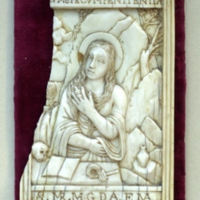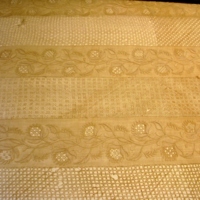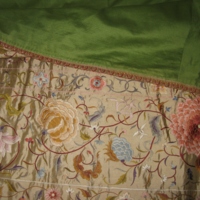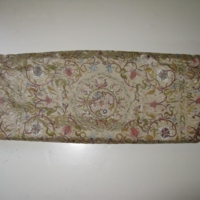Nativity figure (Magi)
Text
Nativity figure, representing the magi king Baltasar, mounted on horseback. The head, the feet and hands are carved in wood and eyes and mouth are painted. The interior is made of wood forming a frame articulated by wires.
Dress in 17th century Spanish fashion with marlota (Robe, a kind of Moorish gown) with cape, vest without sleeves, shirt and pants. The horse is made of papier-mâché painted on a wooden base. It is part of a set consisting of three figures of the Magi on horseback.
Analysis: Both this figure and the kings Gaspar and Melchor who accompany him are dressed in fashion Spanish courtesan of the seventeenth century.
BIBLIOGRAPHY: PEREDA, R. and RODRÍGUEZ BERNIS, S. (com.), El Quixote in his suits, Madrid, 2005, p. 170 [11142]. The production of ivory carvings with western patterns by Filipino artisans focuses from its first creations in the sixteenth century in the religious images of Christ crucified, the Virgin in different invocations and saints that served to reinforce the dogmas of the Church in those lands. They were worked on both exempted one-piece models, reliefs and as elements for dressing images in which only the head, hands and feet are carved in ivory being the rest of the body made of wood and prepared to be covered with rich vestments as in this case.
Group compositions are not frequent although there are some known examples of the Holy Family and some Nativity scenes, both among those of Hispanic-Filipino origin as well as among the Indo-Portuguese (M. ESTELLA: Baroque sculpture of ivory in Spain, I, page 86.).
In contrast to his two companions Melchor and Gaspar, in this case an ebonized wood to represent its head and limbs instead of ivory having special care in the treatment of curly hair. For the vestments to follow the model that imitates the Spanish costumes of the time instead of wearing the traditional clothing oriental with which the black king is represented in contemporary iconography to highlight its exotic origin.
As in another of the horses of his courting companions, this one carries in the head a pinching apotropaic hanging from the head. The three kings wear an ecru silk satin coat or overall with flowers Damask with embroidered plant motifs in gilt silver lamellae stretched out. Although the cuts of these dresses are the same in all cases, silk used varies being identical in those of Melchior and Gaspar while that of King Baltasar differs with floral motifs in yellow. The metallic embroidery designs that adorn the sleeves and trims are different in the three copies.
Share this



